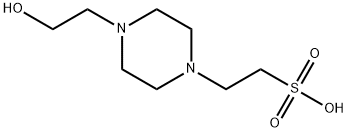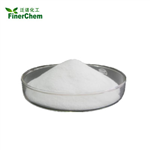Description
HEPES has been described as one of the best all-purpose buffers available for biological research. At biological pH, the molecule is zwitterionic, and is effective as a buffer at pH 6.8 to 8.2 (pKa 7.55). It is typically used in cell culture at concentration between 5mM to 30 mM. HEPES has been used in a wide variety of applications, including tissue culture. It is commonly used to buffer cell culture media in air. HEPES finds its usage in in vitro experiments on Mg.
Chemical Properties
White crystalline powder
Uses
Non-toxic to cell. It is used as a hydrogen ion buffer, which can control the constant pH range for long term. The concentration is 10-50mmol/L. Generally, 20mmol/LHEPES in nutrient solution can get buffer ability.
Uses
HEPES is common buffer for biological sciences, particularly used in cell culture to maintain physiological pH. It acts a buffering component, which is used in the preparation of buffers. It is described as one of the best all-purpose buffers available for use in biological research.
HEPES has been used as a component of:
Hank′s balanced salt solution, Dulbecco′s modified eagle′s medium and no-glucose DMEM, which are used for the preparation of tissue slices.
Buffers used in localized conductance measurements on the basolateral side of culture inserts to examine cation selectivity.
Uses
HEPES is a biological buffer. It may be used in isoelectric focusing applications and as a buffer in the quantitative and selective measurement of antigen-antibody reactions. HEPES is reportedly superior to NaHCO3 in controlling pH in tissue and organ culture. HEPES is not recommended for use with the Folin-Ciocalteu protein assay.
Definition
ChEBI: A HEPES that is ethanesulfonate substituted by a 4-(2-hydroxyethyl)piperazin-4-ium-1-yl group at position 2.
General Description
HEPES buffered saline is a tissue culture buffer, which is used to maintain the pH of cell culture. It is water soluble and atmosphere independent. HEPES destroys magnesium in sodium chloride solutions.
Biological Activity
Multi purpose buffer used in biological research.
Biological Activity
HEPES is a multi purpose HEPES buffer used in cell culture and other biological research. Working pH range in aqueous solution: 6.8 - 8.2. Does not form complexes with metal ions. Used in cell culture media.
Synthesis
The general procedure for the synthesis of 4-hydroxyethylpiperazineethanesulfonic acid from N-hydroxyethylpiperazine and sodium 2-hydroxyethylsulfonate is as follows: 0.5 mole of N-hydroxyethylpiperazine, 0.565 mole of sodium 2-hydroxyethylsulfonate, and 500 ml of methanol were added to a 1000 ml four-necked flask fitted with a refluxing condenser tube, and the condensation reaction was carried out under sufficient stirring. The reaction was first carried out at 50 °C for 2.5 minutes, then gradually heated to reflux and continued for 3.0 hours. The reaction was cooled after completion of the reaction to give a reaction mixture containing 4-hydroxyethylpiperazine ethanesulfonate. The yield of 4-hydroxyethylpiperazine ethanesulfonate was 93.6% as analyzed by high performance liquid chromatography. A 20 liter solution of 4-hydroxyethylpiperazine ethanesulfonate at a mass concentration of 15 wt% was diluted to 5 wt% with deionized water under stirring, followed by removal of sodium chloride by dialysis. Then the purified HEPES product was obtained by evaporation concentration, cooling crystallization and filtration. Finally, the product was washed once with anhydrous methanol and dried under vacuum to obtain purified HEPES.A sample of purified HEPES was dissolved and tested for purity, which showed a purity of 99.9%, a yield of 85.6%, a pH of 6.46, and a concentration of chloride ions of 6.8 μg/g.
Purification Methods
Crystallise the acid from hot EtOH and water. It is a useful buffer. [Beilstein 23 V 376.]
References
[1] Patent: CN106905262, 2017, A. Location in patent: Paragraph 0034; 0035; 0047









